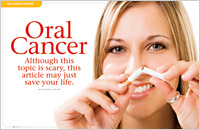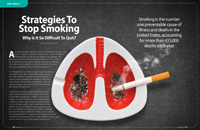Cancer is a scary word, but the more you know about it, the better able you will be to protect yourself and the ones you love. This is particularly true of oral cancer, which is very treatable if caught early. Unfortunately, about two-thirds of oral cancers are not caught until the late stages. You may think that if you are a non-smoker, particularly a young one, this topic is not of concern to you. If so, please think again.
While most oral cancer patients are smokers, the fastest-growing segment of newly diagnosed cases is young, non-smoking adults. The culprit is a particular strain of the Human Papilloma Virus (HPV). HPV is the most common sexually transmitted disease in the U.S., with about 20 million Americans infected. In fact, it is estimated that at least half of all sexually active people will contract it during their lives. Most strains (and there are over 100) lead to symptoms no more serious than warts, and in many cases a person’s own immune system can rid the body of the disease within two years. The strain known as HPV16, unfortunately, is different. By inserting its own DNA into human cells, the virus can cause a mutation that turns normal cells into malignant ones. You may already be aware that HPV16 has been linked to cervical cancer. We now know it is also responsible for many new cases of oral cancer.
Signs & Symptoms

Diagnosis & Treatment
Regular screening for oral cancer is one of the most important services provided to you at the dental office. Your regular dental checkup includes a visual and tactile (touch) examination for any signs of oral cancer or precancerous lesions in and around your mouth and throat. Anything that looks suspicious, may be analyzed with a routine procedure called a biopsy, in which a small amount of the suspicious tissue is sent to a laboratory for microscopic inspection. This is the best way to get a definitive diagnosis. Should the lesion turn out to be cancerous, the rest of the malignant tissue will be removed. It’s possible that radiation and/or chemotherapy will be needed to eradicate the disease. As mentioned before, when treatment occurs early, the survival rates are excellent.
Prevention
There are lifestyle choices you can make to reduce your risk considerably. Giving up tobacco in all forms, along with alcohol are big ones. Avoiding risky sexual behavior is also important. Protect yourself from overexposure to the sun, and eat a healthy diet. Research has consistently found that a high intake of fruits and vegetables is protective against oral and throat cancer; a good diet will also bolster your immune system. And please remember to schedule regular checkups here at the dental office. An oral cancer screening takes just a few minutes, but it could save your life.
Related Articles

Oral Cancer This article may just save your life. Learn how to notice any unusual lesions (sores or ulcers) anywhere in your mouth that do not heal within two-three weeks. Early detection is key… Read Article

Strategies To Stop Smoking Cigarette smoking is the number one preventable cause of illness and death. Quitting smoking could prevent a large number of diseases and deaths each year. Many smokers find it difficult to stop, a fact that is confirmed by the staggering rate of relapse. Given the fact that cigarette smoking is a learned behavior that is reinforced over time, it makes sense that to be successful in quitting, you must “unlearn” this behavior. Here are some suggested ways to learn how… Read Article
